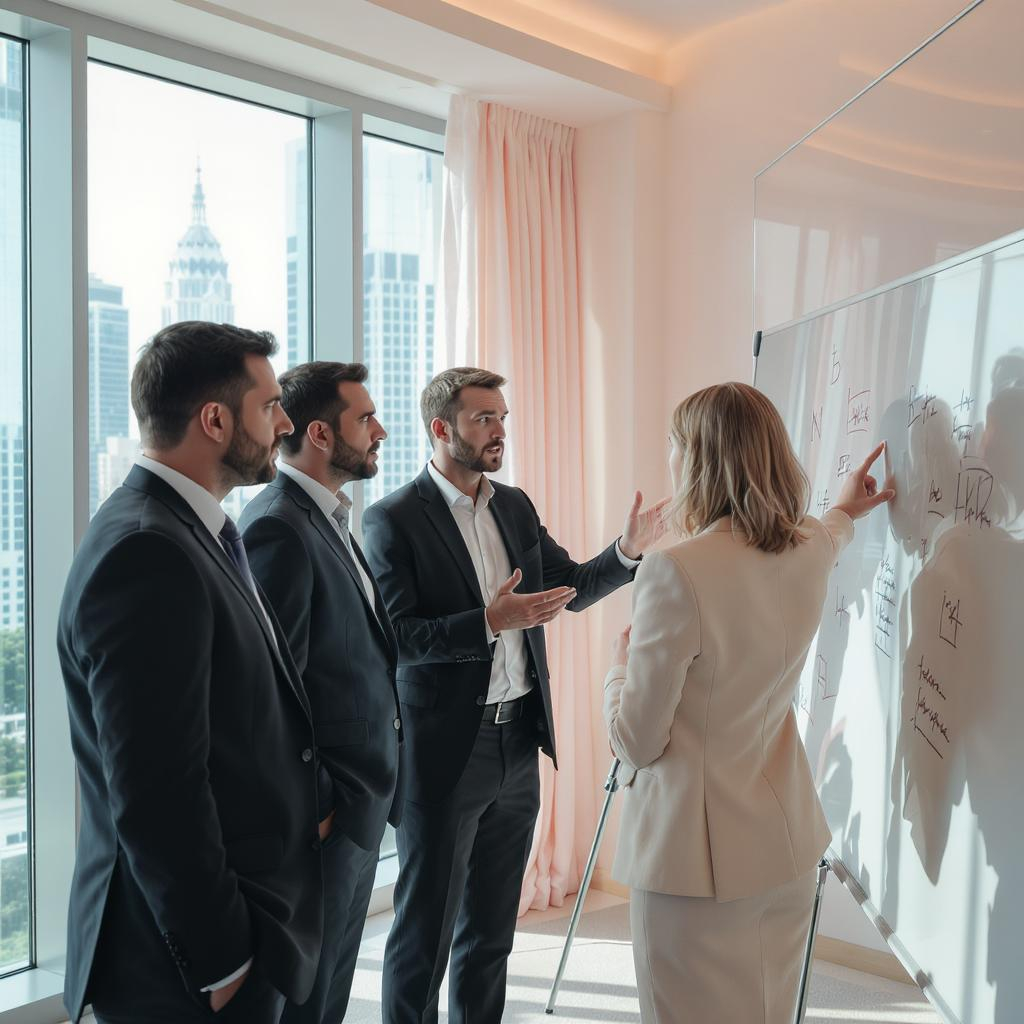Strategic thinkers transforms good plans into real-world success. It’s the difference between strategies that collapse under pressure and those that adapt and thrive.
Most organizations focus heavily on creating strategic plans. But plans alone aren’t enough. When leaders develop strategic thinking throughout their teams, execution becomes more resilient.
Think about it: Every day, people throughout your organization make decisions that either support or undermine your strategy. Without strategic thinking skills, even well-intentioned employees can derail implementation.
The best organizations don’t just communicate their strategy. They build cultures where strategic thinkers can flourishes at every level. They teach people to understand not just what the strategy is, but how to make decisions that align with strategic priorities.
This creates a powerful advantage. When unexpected challenges arise—as they always do—your teams can navigate them without losing strategic momentum.
In this post, I’ll share five essential cultural elements that develop strategic thinking capabilities throughout an organization. These elements create the foundation where your strategy can succeed in the messy real world rather than breaking down during implementation.
Whether you’re leading a large division or an entire enterprise, these insights will help your strategy survive first contact with reality.
What is Business Strategy and Why Does Building Strategic Thinkers Matter?
Strategic thinking is often confused with strategic planning, but they are distinctly different capabilities. While business strategy is your organization’s roadmap to competitive advantage. It defines what you’ll do—and won’t do—to create distinctive value in the marketplace. A clear strategy answers fundamental questions: Where will we compete? How will we win? What capabilities must we develop?
But here’s the challenge: Only 4 in 10 employees clearly understand how their daily work connects to strategic goals. This disconnect creates a dangerous gap between leadership intentions and frontline execution.
When people across your organization understand both the strategy and their role within it, something powerful happens.
Decision quality improves at every level. Resources flow to priorities rather than being scattered across competing initiatives. Teams adapt more quickly to market changes without losing strategic focus.
Think about the alternative: Without strategic clarity, employees make decisions based on departmental objectives, personal preferences, or simply “how we’ve always done things.” Even with the best intentions, this misalignment gradually erodes strategic momentum.
Strategic thinkers aren’t just for executives. Everyone from the C-suite to the front line needs the ability to:
- Connect their daily work to larger organizational goals
- Recognize how their decisions impact strategic priorities
- Identify opportunities and threats relevant to the strategy
- Make trade-offs that strengthen rather than undermine strategic position
The ability to think strategically transforms how your entire organization operates. It becomes the bridge between ambitious plans and successful execution in the real-world business environment.

A Tale of Two Companies: Strategic Thinking in Action
Let me share the story of two companies in the same industry facing identical market challenges—but with dramatically different outcomes.
Company A has a detailed strategic plan gathering dust on the leadership team’s shelves. When market conditions shifted, middle managers continued executing last year’s priorities. Customer-facing teams spotted emerging competitors but had no clear channel to share these insights. By the time leadership recognized the threat, they’d lost significant market share.
In contrast, Company B equipped teams at all levels with strategic thinking capabilities. When early warning signs appeared, frontline employees identified the competitive threat and quickly adapted their approach. Middle managers reallocated resources to address the emerging challenge without waiting for top-down directives. The leadership team received real-time intelligence from throughout the organization, enabling them to refine their strategy before competitors gained traction.
The difference wasn’t the quality of their strategic plans—it was their strategic thinking culture.
Company A treated strategy as a leadership activity that happened once annually. Information flowed primarily downward. Employees focused on executing assigned tasks rather than understanding how their work connected to larger strategic goals.
Company B embedded strategic thinking throughout their organization. They:
- Shared strategic context broadly, not just final decisions
- Created channels for information to flow upward and across silos
- Taught people at all levels to recognize patterns and trends
- Encouraged productive debate about strategic assumptions
- Rewarded decisions that prioritized long-term strategic advantage over short-term gains
The results speak for themselves. While Company A struggled to maintain relevance, Company B outperformed industry averages by consistently identifying opportunities earlier and executing more cohesively than their competitors.
This contrast illustrates why building a culture of strategic thinkers isn’t just a leadership development exercise—it’s a powerful competitive advantage in today’s rapidly evolving business landscape.
The Five Cultural Elements That Create Strategic Thinkers
Strategic thinkers transforms organizations. They turn good companies into great ones. Strategic thinking helps teams navigate complexity with confidence. And it enables people at all levels to make decisions that create lasting value.
But strategic thinking doesn’t happen automatically. It requires specific cultural conditions to flourish.
Through years of research and work with high-performing organizations, I’ve identified five essential elements that create environments where strategic thinking thrives. When these elements are present, people throughout the organization naturally develop the capacity to think strategically about their work.
1. Purpose
Without clear purpose, strategic thinking suffers because people focus on tasks, not outcomes. They follow instructions instead of thinking about why those instructions matter. When purpose is vague or disconnected from daily work, people lack the context needed to make meaningful contributions beyond their immediate responsibilities.
Strategic thinkers need a clear “North Star” that guides decisions across the organization. They require deep understanding of how their specific work connects to larger organizational goals. And they must have permission to question assumptions that don’t align with the stated purpose, regardless of their position in the hierarchy.
This element transforms how people approach their work. Instead of passively waiting for direction, they actively evaluate opportunities through the lens of purpose. They make better trade-offs between competing priorities because they understand what truly matters to the organization’s success.
When Microsoft CEO Satya Nadella clarified the company’s purpose as “empower every person and organization on the planet to achieve more,” it catalyzed strategic thinking throughout the company. Cloud engineers began questioning features that didn’t truly empower users, while customer service representatives identified new ways to help clients succeed with Microsoft products. Product teams started evaluating potential innovations based on empowerment potential rather than just technical feasibility or market size.
This clarity turned thousands of Microsoft employees into strategic thinkers rather than just skilled technicians. It created alignment without requiring micromanagement, as people throughout the organization could independently make decisions that advanced the company’s purpose.
2. Psychological Safety
People won’t think strategically if they’re afraid to speak up or make mistakes. In environments where challenging the status quo leads to punishment or ridicule, employees default to safe, conventional approaches instead of exploring better alternatives. Strategic thinking requires intellectual risk-taking, which only happens when people feel psychologically safe.
Strategic thinkers need comfort raising uncomfortable questions about current practices and assumptions. They require freedom from fear when challenging ideas from more senior or powerful stakeholders. And they must have permission to test new approaches without punishment if those experiments don’t immediately succeed.
The impact of psychological safety on strategic thinking is profound. When people feel safe, they share early warning signs about strategic threats rather than hiding problems. They identify opportunities that might initially seem risky or unconventional. And they collaborate more effectively across teams because they’re not defending territorial boundaries.
Toyota’s famous “stop the line” policy illustrates how psychological safety enables strategic thinking at all levels. By empowering any worker to halt the entire production line when they spot a problem, Toyota created a culture where frontline employees think strategically about quality and process improvement. Workers don’t just follow procedures blindly—they actively identify potential improvements because they know raising concerns is valued rather than punished.
This psychological safety has helped Toyota maintain industry-leading quality despite producing millions of vehicles annually. It transforms assembly line workers from passive executors into strategic thinkers who constantly improve how the company delivers value to customers.
3. Perspective
In isolation, strategic thinking becomes nearly impossible. When teams operate in silos with limited visibility into other parts of the organization, people make decisions that seem optimal from their narrow viewpoint but may actually undermine overall strategic objectives.
Strategic thinkers need visibility into how different parts of the organization work together to create value. They require regular exposure to different perspectives from other functions, disciplines, and levels. And they must have time to connect dots across teams to identify patterns and opportunities that can’t be seen from a single vantage point.
This broader perspective fundamentally changes how people approach problems and opportunities. Instead of sub-optimizing their specific area, they make decisions that benefit the entire organization. They anticipate how changes in one area might impact others. And they identify strategic opportunities at the intersection of different functions or capabilities.
Pixar’s headquarters exemplifies how physical space can promote the perspective needed for strategic thinking. The building was deliberately designed to create random encounters between employees from different departments. The central atrium houses mailboxes, meeting rooms, cafeteria, and coffee bar—ensuring people from all disciplines regularly interact.
When animators regularly chat with story developers and technical engineers, they develop broader perspective that informs their work. These connections enable everyone to think strategically about how their contributions affect the entire system, not just their assigned tasks. The result has been a remarkable string of critically acclaimed and commercially successful films that blend technological innovation with compelling storytelling.
4. Feedback
Without timely feedback, people can’t calibrate their strategic thinking. They may believe they’re making good decisions aligned with organizational priorities when they’re actually missing the mark entirely. And without the discipline of regular feedback loops, even brilliant strategic ideas never get properly tested and refined.
Strategic thinkers need fast, specific feedback on their decisions and actions. They require regular check-ins to ensure their work remains aligned with evolving strategic priorities. And they must engage in structured reflection on what’s working and what isn’t to continuously improve their strategic capabilities.
Effective feedback transforms how people develop as strategic thinkers. Instead of making the same mistakes repeatedly, they quickly learn from missteps. They adapt their approach based on real results rather than assumptions. And they build confidence in their strategic judgment through validated successes.
Bridgewater Associates’ “radical transparency” approach demonstrates how direct feedback builds strategic thinking capability. The world’s largest hedge fund has created a culture where every employee is expected to provide honest, real-time feedback to colleagues at all levels. Their proprietary “Dots” system allows anyone to rate the quality of meetings, decisions, and interactions immediately after they occur, creating rapid feedback loops that force strategic clarity.
This practice requires employees to articulate clear thinking behind their decisions and to constantly refine their strategic judgment based on collective intelligence. Rather than protecting flawed thinking, Bridgewater’s culture exposes weaknesses quickly so they can be addressed. While intimidating to newcomers, this radical transparency has produced world-class strategic thinkers capable of navigating complex global markets with remarkable consistency.
5. Space to Try
Without space to practice, strategic thinking remains theoretical. When every minute is scheduled for immediate deliverables, there’s no room to consider alternative approaches or longer-term implications. Strategic thinking requires both time and psychological space to explore possibilities beyond the urgent.
Strategic thinkers need time allocated specifically for thinking beyond immediate tasks. They require resources to explore promising opportunities that emerge from their strategic thinking. And they must have explicit permission to learn through strategic experiments, even when those experiments don’t yield immediate results.
This space fundamentally changes how people relate to their work. Instead of focusing exclusively on execution, they regularly step back to consider broader implications and alternatives. They develop the habit of connecting daily activities to longer-term outcomes. And they build strategic muscles by actually practicing strategic thinking, not just talking about it.
Google’s “20% time” policy illustrates how creating space for experimentation builds strategic thinking capability. By allowing engineers to spend one-fifth of their work time on projects of personal interest, Google created a mechanism for employees throughout the organization to think strategically about user needs and potential innovations.
This practice produced breakthrough products like Gmail, Google News, and AdSense—not because leadership strategically planned these products, but because individual employees had space to develop as strategic thinkers. The space to try allowed people to develop strategic muscles by identifying opportunities, testing hypotheses, and refining ideas based on feedback—capabilities that benefited all aspects of Google’s business.
Building these five elements into your culture transforms how people work. Instead of waiting for strategic direction from above, strategic thinkers identify opportunities themselves. Rather than blindly executing tasks, they connect their work to larger strategic goals. And when challenges arise, they adapt with strategic thinking rather than simply escalating problems.
Strategic thinking isn’t a skill reserved for executives. It’s a capability your entire organization can develop—if you create the right cultural conditions for it to flourish.

Integrating the Five Elements: Creating Strategic Thinkers
The true power of strategic thinkers emerges when all five elements work together as an integrated system. Psychological safety creates the foundation for purpose-driven work. Clear purpose provides direction for gaining broader perspective. Expanded perspective creates opportunities for meaningful feedback. And effective feedback systems ensure continuous improvement that creates space for strategic experimentation.
To develop strategic thinkers in your organization:
- Daily Practice: Incorporate strategic exercises into their regular routine
- Learning Community: Create groups of peers committed to developing as strategic thinkers
- Diverse Inputs: Expose strategic thinkers to ideas and perspectives outside their industry or function
- Reflection Rituals: Establish regular times for strategic thinkers to consider larger patterns
- Implementation Focus: Help strategic thinkers apply insights to real-world decisions and track results
Remember that strategic thinkers develop through practice. By consciously cultivating each element, you’ll develop people who bring strategic capabilities to all aspects of your organization.
Common Obstacles to Developing Strategic Thinkers and How to Overcome Them
Even with the best intentions, several common obstacles can derail efforts to develop strategic thinkers:
- Information Overload: In today’s data-saturated environment, distinguishing signal from noise becomes challenging
- Solution: Establish clear information filters based on your strategic priorities
- Short-Term Pressures: Immediate deadlines and crises often crowd out longer-term thinking
- Solution: Block dedicated time for strategic reflection that cannot be compromised
- Cognitive Biases: Our brains are wired with numerous biases that distort strategic perception
- Solution: Develop specific practices to counter your most common biases
- Execution Obsession: Many organizations value action over thought, creating a bias against reflection
- Solution: Frame strategic thinking as a form of “mental execution” essential to results
- Siloed Expertise: Strategic insights often emerge at the intersection of different domains
- Solution: Deliberately cultivate relationships across functional and industry boundaries
By recognizing and addressing these obstacles proactively, you can maintain momentum in developing strategic thinkers even in challenging environments.
Conclusion: Transform Your Organization Through Strategic Thinkers
Developing strategic thinkers is no longer optional for organizations that want to thrive in today’s complex business landscape. By mastering the five essential elements—purpose, psychological safety, perspective, feedback, and space to try—you’ll cultivate strategic thinkers who distinguish your organization from competitors.
The approaches outlined in this guide offer concrete starting points for building each element. Begin with the areas where your organization is weakest, and remember that developing strategic thinkers is a journey of continuous improvement rather than a destination.
As you integrate these practices into your organization, your strategic thinkers will make more insightful decisions, spot opportunities others miss, and create greater value in everything they do. In a world of increasing volatility and uncertainty, strategic thinkers provide the competitive advantage that will guide your success in 2025 and beyond.
Recent research from National University indicates that 83% of companies consider developing strategic thinkers a top priority in their business plans, while an IBM study found that 94% of data and AI leaders believe having strategic thinkers is becoming even more critical in the AI era. Organizations that develop strategic thinkers systematically will hold a significant advantage in navigating the increasing complexity of the business environment.
Are you ready to transform your organization by developing strategic thinkers? Which of the five elements will you focus on first?
Taking the Next Step
For organizations seeking support in developing strategic thinkers, The Mean MBA Consultancy offers three core services:
- Strategic Thinkers Intensives: Focused sessions to develop strategic capability at all levels
- Team and Leadership Retreats: Immersive experiences to build collective strategic thinking
- Strategy and Systems Design: Comprehensive solutions to embed strategic thinkers throughout the organization
Contact us to learn how we can help your team master the five elements that create strategic thinkers and create sustainable competitive advantage..
Ready to transform how your team thinks and works together?
In today’s AI-driven business landscape, strategic thinking isn’t a luxury—it’s essential for survival. Our Strategic Thinker Signature Intensive helps your team connect daily decisions to your company’s vision, think collaboratively to boost productivity, and eliminate costly waste.
What you’ll gain:
- Clear alignment between individual roles and company mission
- Enhanced team collaboration and strategic decision-making
- Practical tools to leverage AI and emerging technologies
- Reduced operational waste and increased efficiency
Choose your path:
- For Everyone: Build strategic thinking across your entire organization
- For Leaders: Advanced intensive for executives and managers
Don’t let your competition outthink you. Transform your team into strategic thinkers who drive real results.
or




